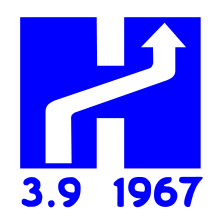- Dagen H
-
"H-Day" redirects here. For the article on the day when traffic in Iceland was switched to driving on the right, see H-dagurinn.
 Kungsgatan, Stockholm on Dagen H
Kungsgatan, Stockholm on Dagen H
Dagen H (H day), today mostly called "Högertrafikomläggningen" ("The right-hand traffic diversion"), was the day, 3 September 1967, on which traffic in Sweden switched from driving on the left-hand side of the road to the right. The "H" stands for "Högertrafik", the Swedish word for "right-hand traffic".
Contents
Background
There were various major arguments for the change:
- All Sweden's immediate neighbours drove on the right (including Norway, with which Sweden has a long land border).
- Most Swedes drove left-hand drive (LHD) vehicles. This led to many head-on collisions when passing on two-lane highways, which were common in Sweden because of its low population density and traffic levels.
Nonetheless, the change was widely unpopular, and had repeatedly been voted down over the previous forty years. In a 1955 referendum, 83 percent voted to keep driving on the left. In 1963, the Riksdag approved the change and established the Statens Högertrafikkommission (HTK) ("state right-hand traffic commission") to oversee it. It also began implementing a four-year education program, with the advice of psychologists.[1]
The campaign included displaying the Dagen H logo on various commemorative items, including milk cartons, men's shorts[1] and women's underwear.[2] Swedish television held a contest for songs about the change; the winning entry was Håll dig till höger, Svensson ('Keep to the right, Svensson') by Rock-Boris.
As Dagen H neared, every intersection was equipped with an extra set of poles and traffic signals wrapped in black plastic. Workers roamed the streets early in the morning on Dagen H to remove the plastic. Similarly, a parallel set of lines were painted onto the roads with white paint, then covered with black tape. Before Dagen H, Swedish roads had used yellow lines.
The switch
On Dagen H, Sunday, September 3rd, all non-essential traffic was banned from the roads from 01:00 to 06:00. Any vehicles on the roads during that time had to follow special rules. All vehicles had to come to a complete stop at 04:50, then carefully change to the right-hand side of the road and stop again before being allowed to proceed at 05:00. In Stockholm and Malmö, however, the ban was longer—from 10:00 on Saturday until 15:00 on Sunday—to allow work crews to reconfigure intersections. Certain other towns also saw an extended ban, from 15:00 on Saturday until 15:00 on Sunday.
One-way streets presented unique problems. Bus stops had to be constructed on the other side of the street. Intersections had to be reshaped to allow traffic to merge.
Trams in central Stockholm, in Helsingborg and most lines in Malmö were withdrawn and replaced by buses, and over one thousand new buses were purchased with doors on the right-hand side. Some 8,000 older buses were retrofitted to provide doors on both sides, while Gothenburg exported its RHD buses to Pakistan and Kenya. The modification of buses, paid by the state, was the largest cost of the change. In Gothenburg and Norrköping, and in two Stockholm suburbs, tram networks continued to operate.
In order to avoid blinding the oncoming drivers, all Swedish vehicles had to have their original left-hand-traffic headlamps replaced with right-hand units. One of the reasons the Riksdag pushed ahead with Dagen H despite public unpopularity was that most vehicles in Sweden at the time used inexpensive, standardized round headlamps, but the trend towards more expensive model-specific headlamps had begun in Continental Europe and was expected to spread through most other parts of the world. Further delay in changing over from left- to right-hand traffic would have greatly increased the cost burden to vehicle owners.
Results
On the Monday following Dagen H, there were 125 reported traffic accidents, compared to a range of 130 to 198 for previous Mondays. No fatal traffic accidents were attributed to the switch. Experts suggested that changing to driving on the right would reduce accidents as people already drove left-hand drive vehicles, thereby having a better view of the road ahead. Indeed, fatal car-to-car and car-to-pedestrian accidents dropped sharply as a result. Some of the decrease was attributed to a reduction in speed limits by 10 km/h for some time after the switch. The accident rate rose back to its original level within two years.
See also
- H-dagurinn
- 730 (transport)
- Right and left hand traffic
- Switch to right hand traffic in Czechoslovakia
- Transport in Sweden
References
External links
Categories:- History of Sweden
- Transport in Sweden
- 1967 in Sweden
Wikimedia Foundation. 2010.

